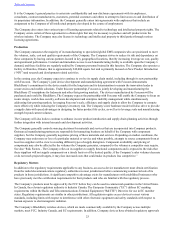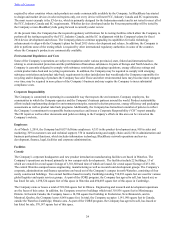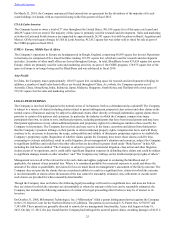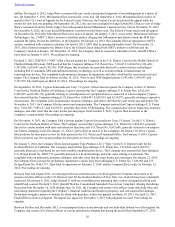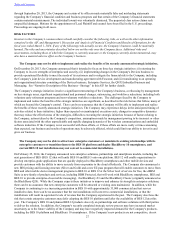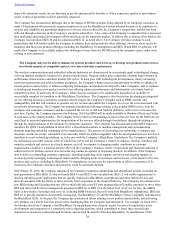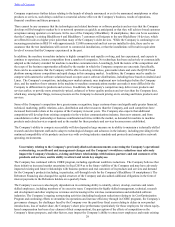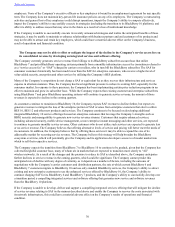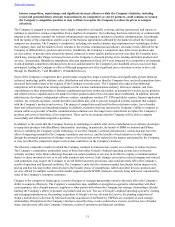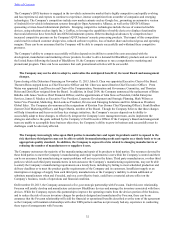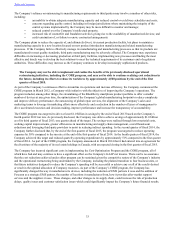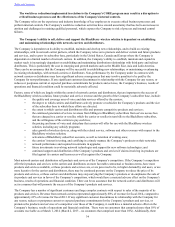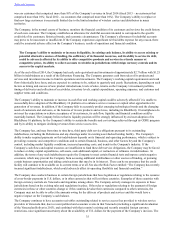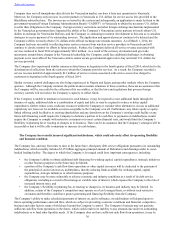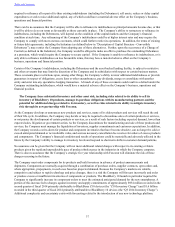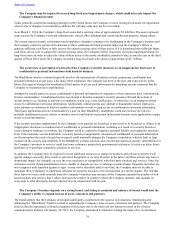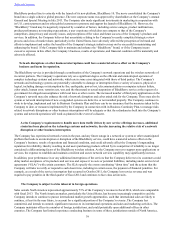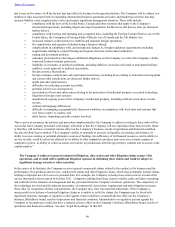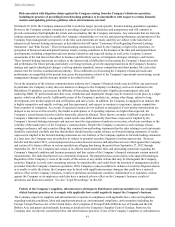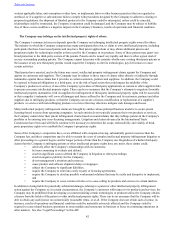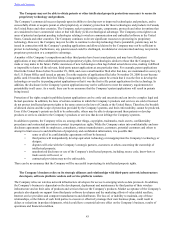Blackberry 2014 Annual Report Download - page 41
Download and view the complete annual report
Please find page 41 of the 2014 Blackberry annual report below. You can navigate through the pages in the report by either clicking on the pages listed below, or by using the keyword search tool below to find specific information within the annual report.
33
The Company’s reliance on outsourcing its manufacturing requirements to third parties may involve a number of other risks,
including:
• an inability to obtain adequate manufacturing capacity and reduced control over delivery schedules and costs;
• concerns regarding quality control, including in foreign jurisdictions where maintaining the integrity of the
control systems implemented by the Company may be more difficult to monitor and manage;
• reduced control over the Company’s intellectual property;
• increased risk of counterfeit and fraudulent activities giving rise to the availability of unauthorized devices; and
• early termination of, or failure to renew, contractual arrangements.
The Company plans to reduce the capacity of, and ultimately divest, its current production facility, but plans to maintain a
manufacturing capacity in a new location focused on new product introduction manufacturing and related manufacturing
processes. If the Company fails to effectively manage its manufacturing and manufacturing processes so that its products are
manufactured to meet quality standards, third party manufacturing may be adversely affected. The Company may experience
difficulties in increasing or decreasing production at third party facilities, implementing new processes and finding the most
effective and timely way to develop the best solutions to meet the technical requirements of its customers and of regulatory
authorities. These difficulties may increase as the Company continues to develop increasingly sophisticated products.
The Company may not be able to implement and realize the benefits of its previously-disclosed operational
restructuring initiatives, including the CORE program, and may not be able to continue realizing cost reductions in
the future, including its efforts to reduce its workforce by approximately 4,500 positions by the end of the first
quarter of fiscal 2015.
As part of the Company’s continuous effort to streamline its operations and increase efficiency, the Company commenced the
CORE program in March 2012, a Company-wide initiative with the objective of improving the Company’s operations. The
program included, among other things, the streamlining of the BlackBerry smartphone product portfolio to offer a smaller
number of devices at any given time, the optimization of the Company’s global manufacturing footprint to reduce complexity
and improve delivery performance, the outsourcing of global repair services, the alignment of the Company’s sales and
marketing teams to leverage its marketing efforts more effectively and a reduction in the number of layers of management to
drive accelerated execution and decision making, improve performance and increase the transparency of accountability.
The CORE program was targeted to drive at least $1.0 billion in savings by the end of fiscal 2013 based on the Company’s
fourth quarter 2012 run rate. As previously disclosed, the Company was able to achieve savings of approximately $1.0 billion
as of its third quarter of fiscal 2013, one quarter ahead of the target. The savings were realized through lower material costs,
working capital improvements, greater efficiencies in manufacturing and supply chain management, overall headcount
reductions and leveraging third-party providers to assist in reducing indirect spending. In the second quarter of fiscal 2014, the
Company further disclosed that, by the end of the first quarter of fiscal 2015, the program was targeted to reduce operating
expenses by 50% compared to the run rate at the end of the first quarter of fiscal 2014. In the fourth quarter of fiscal 2014, the
Company achieved this target and reduced quarterly operating expenditures by approximately 51% compared to the first quarter
of fiscal 2014. As part of the CORE program, the Company announced in March 2014 that it had entered into an agreement for
the divestiture of the majority of its real estate holdings in Canada, with an expected closing in the first quarter of fiscal 2015.
The Company has incurred significant costs in implementing the Cost Optimization Program and the CORE program, all of
which have had and may continue to have a significant effect on the Company's GAAP net income. There can be no assurance
that the cost reductions achieved under either program can be sustained given the competitive nature of the Company’s industry
and the operational restructuring being undertaken by the Company, including the planned transition to four business units, or
that future initiatives designed to reduce the Company’s spending will be successful or achieve any or all of the results desired
or result in the optimal allocation of Company resources. As part of the Company’s CORE program, the Company has
significantly changed the way it manufactures its devices, including the reduction of EMS partners it uses and the addition of
Foxconn as a strategic EMS partner, the number of locations it manufactures from, how it provides after-market support
services and the suppliers it uses. These changes, and other changes to its supply chain, could increase the risk of production
delays, quality issues and customer satisfaction issues which could significantly impact the Company’s future financial results.
Table of Contents


